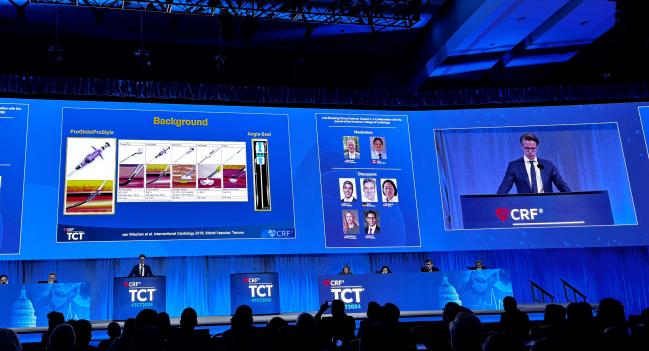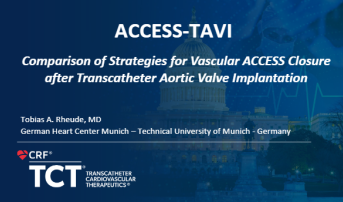Vascular Closure via Suture/Plug Combo Reduces Complications: ACCESS-TAVI
The rate of major and minor vascular complications was halved compared with a suture-only strategy.

WASHINGTON, DC—For vascular closure after transfemoral TAVI, a strategy that combines suture- and plug-based devices halves the risk of access site-related vascular complications during a patient’s’ index hospital stay compared with employing two suture-based devices, the randomized ACCESS-TAVI trial shows.
“Constant refinements of procedural techniques as well as device iterations resulted in improved outcomes after TAVI procedures over the years,” Tobias A. Rheude, MD (Deutsches Herzzentrum München, Germany), said in the Main Arena last week at TCT 2024. “Nevertheless, access-related vascular complications after TAVI remain common.”
Data on the topic remain limited, said Rheude, with just two randomized trials in the literature: CHOICE-CLOSURE and MASH. “There are several vascular closure devices commercially available,” he pointed out. Among them are Perclose ProGlide/ProStyle (Abbott) and Angio-Seal (Terumo), which some operators have used in combination over the past few years, with some observational data to support this strategy.
ACCESS-TAVI was intended to fill in the knowledge gap, Rheude indicated.
The investigators enrolled 454 patients slated to undergo transfemoral TAVI, randomizing them to receive either the Perclose ProGlide/ProStyle suture-based device plus the Angio-Seal plug or two of the Perclose ProGlide/ProStyle devices for closure.
Mean age was 80 years in both study arms, though the suture/plug group had a higher prevalence of women compared with the suture-only group (51.7% vs 42.0%; P = 0.046) and lower body mass index (mean 26.2 vs 27.1 kg/m2; P = 0.034). Other baseline characteristics were similar, with a mean EuroSCORE II of 4.5 and around 10% of patients having peripheral artery disease.
For puncture, researchers recommended use of ultrasound guidance, which ultimately was performed in nearly 60% of patients, while selection of the secondary vascular access was up to operator discretion. There were no differences between the groups when it came to access characteristics and most procedural characteristics, though procedure times were shorter with the suture/plug strategy than with the suture-only strategy (mean 55.3 min vs 59.4 min; P = 0.024). Nearly all cases involved conscious sedation, and for around 45% the secondary access was transradial.
Just 5.2% of patients in the suture/plug group required an additional vascular closure device, as opposed to 41.1% in the suture-only group (P < 0.001). Most often this device was either a 6-Fr or 8-Fr Angio-Seal. Manual compression times of 3 minutes or longer were less common in suture/plug cases versus suture-only cases (15.7% vs 44.4%), with mean times to hemostasis of 108 versus 206 seconds, respectively (P < 0.001 for both comparisons).
The primary endpoint—a composite of major or minor access site-related vascular complications according to VARC-3 criteria during the index hospitalization—happened less often with the suture/plug strategy than with the suture-only strategy (27% vs 54%; RR 0.55; 95% CI 0.44-0.68). The difference was driven by a lower rate of minor access site-related vascular complications (23.5% vs 47.3%; P < 0.001), with no difference in major complications (3.5% vs 6.5%; P = 0.125). Additionally, the rates of type 2 or greater bleeding events favored the suture/plug (5.7% vs 11.6%; P = 0.25).
At 30 days, complication rates followed similar patterns and there was no difference in all-cause mortality between the two groups.
In terms of limitations to their study, “a cost-effectiveness analysis to illuminate the economic impact of the findings is of interest, though it was not incorporated in the trial design,” Rheude said.
Discussant Rahul P. Sharma, MD (Stanford Health Care, CA), said the ACCESS-TAVI trial “actually gives us very practical insights into an issue that we have some control over in the lab.” He questioned why the need for an additional plug-based device was so much lower in this study than in the earlier CHOICE-CLOSURE.
The difference between the two trials, said Rheude, relates to the strategies being compared. For the dual-suture groups, the need for another device was similar in both ACCESS-TAVI and CHOICE-CLOSURE. It’s just that the suture/plug combination did so well, he explained. “In the end, it seems to be a very safe and effective strategy,” but also importantly helps to streamline the TAVI procedure.
Caitlin E. Cox is News Editor of TCTMD and Associate Director, Editorial Content at the Cardiovascular Research Foundation. She produces the…
Read Full BioSources
Rheude TA. ACCESS-TAVI: comparison of strategies for vascular access closure after transcatheter aortic valve implantation. Presented at: TCT 2024. October 29, 2024. Washington, DC.
Disclosures
- Rheude reports grant/research support from Boston Scientific; consultant fees/honoraria from AstraZeneca, Abbott, SIS Medical, and Translumina; as well as other financial benefit from Boehringer Ingelheim.
- Sharma reports being a physician proctor for Abbott and Edwards Lifesciences.






Comments